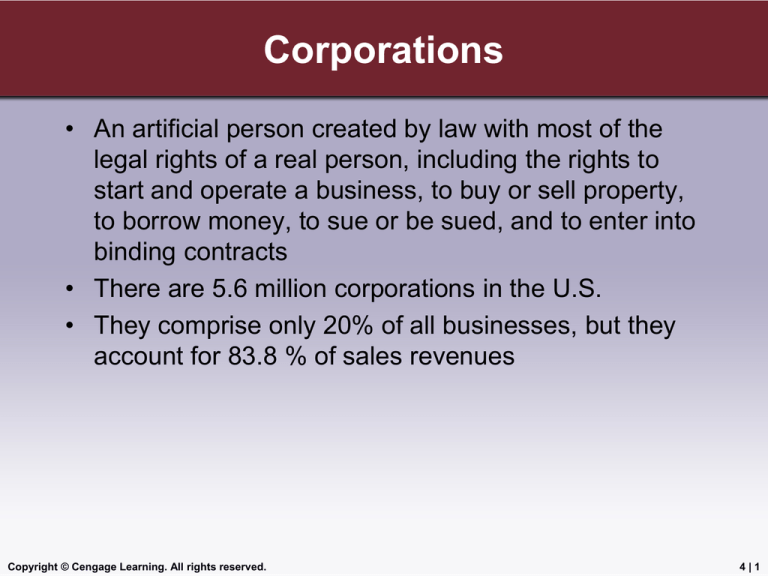
Corporations
• An artificial person created by law with most of the
legal rights of a real person, including the rights to
start and operate a business, to buy or sell property,
to borrow money, to sue or be sued, and to enter into
binding contracts
• There are 5.6 million corporations in the U.S.
• They comprise only 20% of all businesses, but they
account for 83.8 % of sales revenues
Copyright © Cengage Learning. All rights reserved.
4|1
The Seven Largest U.S. Industrial
Corporations, Ranked by Sales Revenue
Source: Fortune website at www.fortune.com, accessed September 12, 2008.
Copyright © Cengage Learning. All rights reserved.
4|2
Corporate Ownership
• Corporate ownership
– Stock
• The shares of ownership of a corporation
– Stockholder
• A person who owns a corporation’s stock
– Closed corporation
• A corporation whose stock is owned by relatively few
people and is not sold to the general public
– Open corporation
• A corporation whose stock is bought and sold on
security exchanges and can be purchased by any
individual
Copyright © Cengage Learning. All rights reserved.
4|3
Forming a Corporation
• Incorporation
– The process of forming a corporation
• Most experts recommend consulting a lawyer
Copyright © Cengage Learning. All rights reserved.
4|4
When Legal Help Is Required
Copyright © Cengage Learning. All rights reserved.
4|5
Forming a Corporation (cont’d)
• Where to incorporate
– Businesses can incorporate in any state they choose
– Some states offer fewer restrictions, lower taxes, and
other benefits to attract new firms
– Domestic corporation
• A corporation in the state in which it is incorporated
– Foreign corporation
• A corporation in any state in which it does business
except the one it which it is incorporated
– Alien corporation
• A corporation chartered by a foreign government and
conducting business in the U.S.
Copyright © Cengage Learning. All rights reserved.
4|6
Forming a Corporation (cont’d)
• Articles of incorporation
– A contract between the corporation and the state in
which the state recognizes the formation of the
artificial person that is the corporation
– Articles of incorporation includes
• Firm’s name and address
• Incorporators’ names and addresses
• Purpose of the corporation
• Maximum amount of stock and types of stock to be
issued
• Rights and privileges of stockholders
• Length of time the corporation is to exist
Copyright © Cengage Learning. All rights reserved.
4|7
Forming a Corporation (cont’d)
• Stockholders’ rights
– Common stock
• Stock owned by individuals or firms who may vote on
corporate matters but whose claims on profit and assets
are subordinate to the claims of others
– Preferred stock
• Stock owned by individuals or firms who usually do not
have voting rights but whose claims on dividends are
paid before those of common-stock holders
– Dividend
• A distribution of earnings to the stockholders of a
corporation
– Proxy
• A legal form listing issues to be decided at a
stockholders’ meeting and enabling stockholders to
transfer their voting rights to some other individual or
individuals
Copyright © Cengage Learning. All rights reserved.
4|8
Forming a Corporation (cont’d)
• Organizational meeting
– The last step in forming a corporation
• The incorporators and original stockholders
meet to elect their first board of directors
– Board members are directly responsible to
stockholders for how they operate the firm
Copyright © Cengage Learning. All rights reserved.
4|9
Corporate Structure
• Board of directors
– The top governing body of a corporation, the
members of which are elected by the
stockholders
– Responsible for setting corporate goals,
developing strategic plans to meet those
goals, and the firm’s overall operation
– Outside directors: experienced managers or
entrepreneurs from outside the corporation
who have specific talents
– Inside directors: top managers from within the
corporation
Copyright © Cengage Learning. All rights reserved.
4 | 10
Corporate Structure (cont’d)
• Corporate officers
– The chairman of the board, president,
executive vice presidents, corporate secretary,
treasurer, and any other top executive
appointed by the board
– Implement the chosen strategy and direct the
work of the corporation, periodically reporting
results to the board and stockholders
Copyright © Cengage Learning. All rights reserved.
4 | 11
Hierarchy of Corporate Structure
• Stockholders exercise a great deal of
influence through their right to elect the board
of directors
Copyright © Cengage Learning. All rights reserved.
4 | 12




